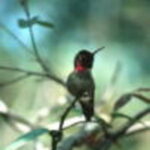The oak tree, a member of the beech family, has about 450 species throughout the temperate climates of the world. Humans use the oak tree for many purposes, such as shade, decoration, and timber. However, thousands of other living things depend on the oak tree for something even more important–a home.
The oak-bark beetle, for example, depends on the oak tree for its survival. The female oak-bark beetle gnaws a vertical tunnel into the bark of the tree, forming a chamber where she deposits her eggs. The larvae develop in or under the bark. When they emerge, they gnaw tunnels of their own away from the original chamber, creating a vast network of tunnel homes.
The nut weevil uses the oak tree in a similar way. This insect has a long, thin, distinctive snout called a rostrum. The female’s rostrum is longer than the male’s. She uses it to drill a hole into an acorn (the fruit of the oak tree), where she lays her eggs. The larvae hatch and grow inside the nut till they are ready to pupate.
Another animal that lives in the oak tree is the gall wasp, which is responsible for the strange-looking applelike structures found on some oak trees. Such a structure, found on many kinds of plants, is generically called a “gall,” an abnormal outgrowth or swelling of plant tissue caused by infection (from bacteria, for example) or by irritation from insects.
A gall on an oak tree is more specifically called an “oak apple,” a large round gall that a gall wasp produces on oak twigs and leaves. Inside the oak apple are up to thirty larvae of the gall wasp. The larvae live and feed inside the gall till they become winged adults, able to fly away.
Many Lepidoptera species (butterflies, moths) use the oak tree to host their larvae. For example, the gypsy moth lays eggs on the trunk and branches of the tree. Later the newly hatched larvae, hanging from the host tree on silken threads, float away on the wind.
Larger animals, too, live in the oak tree. Among them are some tree squirrels, such as the fox squirrel, which is attracted to the oak tree by the acorn as a steady source of food. In the summertime the fox squirrel’s home is a simple little platform of sticks high in the branches of the tree. However, in the wintertime the squirrel typically lives in a hollowed-out den in the tree trunk, sometimes one used by a succession of squirrel occupants over as many as thirty years.
Innumerable foraging birds nest and feed in the oak tree. Bats often roost behind loose bark.
A wide array of plant life, too, attaches itself to the oak tree. Fungus commonly grows on oak tree branches. Many species of lichen call the oak tree home. Sometimes the oak tree hosts the fabled parasite mistletoe.
Oak trees often live for hundreds of years. During that time, they serve as one of the natural world’s most important homes for countless living things.
(Principal sources: Encyclopaedia Britannica; Eyewitness Encyclopedia of Nature, www.dk.com)






